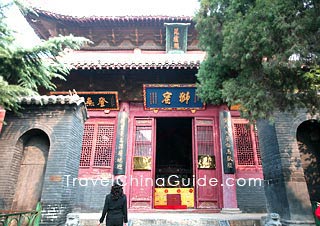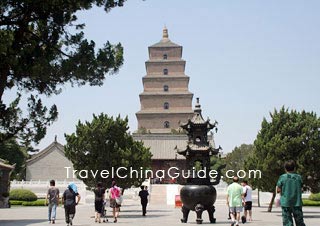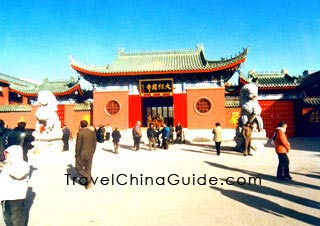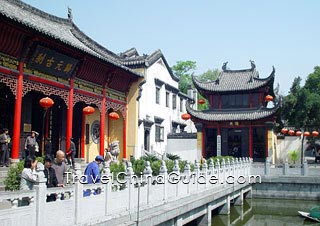Buddhist Temples in China
General Introduction
 |
| White Horse Temple, Luoyang |
Buddhism was introduced into China mainly during Eastern Han Dynasty (25 - 220) via the South China Sea and Western Region. The Buddhist temple was adapted to Chinese tastes when it arrived in China. Its general layout follows Chinese traditional type - courtyard with dome-shaped structure called a stupa as its principal part. A lecture hall, refectory, sutra depository and monks' rooms are distributed along the central axis. Unlike the paintings and decorations in Christian churches which present a heavenly afterlife, Chinese Buddhist temples reveal an atmosphere closer to worldly life.
Figures of Buddha and the bones of Buddha's relics are worshipped in the temples which were called Futu, Lanruo, Chanlin, Daochang, Jialan and Zhaoti in different dialects of Chinese.
Development
 |
| Big Wild Goose Pagoda, Xi'an |
![]() Eastern Han Dynasty - Eastern Jin Dynasty (317 - 420): Buddhism was introduced to China during this period. The early Chinese Buddhist temples followed Indian style, which set the stupa as its center. They once had a traditional Chinese name - Ci (ancestral temple) and the number was very limited. White Horse Temple in Luoyang is a typical example of this period.
Eastern Han Dynasty - Eastern Jin Dynasty (317 - 420): Buddhism was introduced to China during this period. The early Chinese Buddhist temples followed Indian style, which set the stupa as its center. They once had a traditional Chinese name - Ci (ancestral temple) and the number was very limited. White Horse Temple in Luoyang is a typical example of this period.
![]() Northern and Southern Dynasties (386 - 589) to Five Dynasties (907 - 960): Buddhism was at its height of splendor and power during this period. In the Tang Dynasty (618 - 907), a lot of Buddhist doctrines were translated and the main Buddhist sects were formed and developed. Many more Buddhist temples were built with larger dimensions. Walls of the courtyard were decorated with exquisite embossment. A niche was placed in the middle of the north wall. A Buddhist pylon stood in the centre of the temple. The Big Wild Goose Pagoda in Xi'an was built in this period.
Northern and Southern Dynasties (386 - 589) to Five Dynasties (907 - 960): Buddhism was at its height of splendor and power during this period. In the Tang Dynasty (618 - 907), a lot of Buddhist doctrines were translated and the main Buddhist sects were formed and developed. Many more Buddhist temples were built with larger dimensions. Walls of the courtyard were decorated with exquisite embossment. A niche was placed in the middle of the north wall. A Buddhist pylon stood in the centre of the temple. The Big Wild Goose Pagoda in Xi'an was built in this period.
 |
| Xiangguo Temple, Kaifeng |
Temple Layout
 |
| Guiyuan Temple, Wuhan |
Bodhisattva Hall worships the main Bodhisattva of a temple, the enlightened being who seeks to enlighten others, is located behind. Next is the lecture hall, the place where Buddhist doctrines are delivered. Sutra Depository, where Buddhist books, sutras and scriptures are stored is situated at the back. Refectories, monks' rooms and other attached architecture are distributed along the central axis. Buddhism advocates that people act with leniency. An area where captive animals are freed to show the charity of human souls and to accumulate merit for the afterlife can be found in most Buddhist temples. Generally speaking, this is the common layout of Chinese Buddhist temples.
Further Reading: Da Ci'en Temple
Chinese Temples
- Buddhist Temples
- Taoist Temples
- Islamic Mosques
- Confucius Temples
- Chinese Temples Pictures